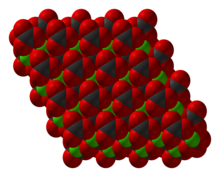
Back Kalsiumkarbonaat Afrikaans Carbonato calcico AN كربونات الكالسيوم Arabic Carbonatu de calciu AST Kalsium karbonat Azerbaijani کلسیوم کربونات AZB Кальций карбонаты Bashkir Калциев карбонат Bulgarian ক্যালসিয়াম কার্বনেট Bengali/Bangla Kalcij-karbonat BS
 | |
 | |
 | |
| Names | |
|---|---|
| IUPAC name
Calcium carbonate
| |
| Other names | |
| Identifiers | |
3D model (JSmol)
|
|
| ChEBI | |
| ChEMBL | |
| ChemSpider | |
| DrugBank | |
| ECHA InfoCard | 100.006.765 |
| EC Number |
|
| E number | E170 (colours) |
| KEGG | |
PubChem CID
|
|
| RTECS number |
|
| UNII | |
CompTox Dashboard (EPA)
|
|
| |
| |
| Properties | |
| CaCO3 | |
| Molar mass | 100.0869 g/mol |
| Appearance | Fine white powder or colorless crystals; chalky taste |
| Odor | odorless |
| Density | 2.711 g/cm3 (calcite) 2.83 g/cm3 (aragonite) |
| Melting point | 1,339 °C (2,442 °F; 1,612 K) (calcite) 825 °C (1,517 °F; 1,098 K) (aragonite)[4][5] |
| Boiling point | decomposes |
| 0.013 g/L (25 °C)[1][2] | |
Solubility product (Ksp)
|
3.3×10−9[3] |
| Solubility in dilute acids | soluble |
| Acidity (pKa) | 9.0 |
| −3.82×10−5 cm3/mol | |
Refractive index (nD)
|
1.59 |
| Structure | |
| Trigonal | |
| 32/m | |
| Thermochemistry | |
Std molar
entropy (S⦵298) |
93 J/(mol·K)[6] |
Std enthalpy of
formation (ΔfH⦵298) |
−1207 kJ/mol[6] |
| Pharmacology | |
| A02AC01 (WHO) A12AA04 (WHO) | |
| Hazards | |
| NFPA 704 (fire diamond) | |
| Lethal dose or concentration (LD, LC): | |
LD50 (median dose)
|
6450 mg/kg (oral, rat) |
| NIOSH (US health exposure limits): | |
PEL (Permissible)
|
TWA 15 mg/m3 (total) TWA 5 mg/m3 (resp)[7] |
| Safety data sheet (SDS) | ICSC 1193 |
| Related compounds | |
Other anions
|
Calcium bicarbonate |
Other cations
|
|
Related compounds
|
Calcium sulfate |
Except where otherwise noted, data are given for materials in their standard state (at 25 °C [77 °F], 100 kPa).
| |

Calcium carbonate is a chemical compound with the chemical formula CaCO3. It is a common substance found in rocks as the minerals calcite and aragonite, most notably in chalk and limestone, eggshells, gastropod shells, shellfish skeletons and pearls. Materials containing much calcium carbonate or resembling it are described as calcareous. Calcium carbonate is the active ingredient in agricultural lime and is produced when calcium ions in hard water react with carbonate ions to form limescale. It has medical use as a calcium supplement or as an antacid, but excessive consumption can be hazardous and cause hypercalcemia and digestive issues.[8]
- ^ Aylward, Gordon; Findlay, Tristan (2008). SI Chemical Data Book (4th ed.). John Wiley & Sons Australia. ISBN 978-0-470-81638-7.
- ^ Rohleder, J.; Kroker, E. (2001). Calcium Carbonate: From the Cretaceous Period Into the 21st Century. Springer Science & Business Media. ISBN 978-3-7643-6425-0.
- ^ Benjamin, Mark M. (2002). Water Chemistry. McGraw-Hill. ISBN 978-0-07-238390-4.
- ^ "Occupational safety and health guideline for calcium carbonate" (PDF). US Dept. of Health and Human Services. Archived (PDF) from the original on 30 April 2011. Retrieved 31 March 2011.
- ^ "CRC Handbook of Chemistry and Physics" (PDF). Archived from the original (PDF) on 29 October 2018. Retrieved 29 October 2018.
- ^ a b Zumdahl, Steven S. (2009). Chemical Principles 6th Ed. Houghton Mifflin Company. p. A21. ISBN 978-0-618-94690-7.
- ^ NIOSH Pocket Guide to Chemical Hazards. "#0090". National Institute for Occupational Safety and Health (NIOSH).
- ^ Strumińska-Parulska, DI (2015). "Determination of 210Po in calcium supplements and the possible related dose assessment to the consumers". Journal of Environmental Radioactivity. 150: 121–125. doi:10.1016/j.jenvrad.2015.08.006. PMID 26318774.
